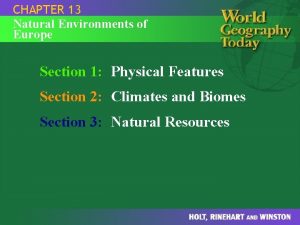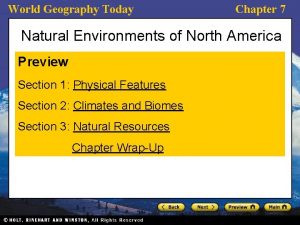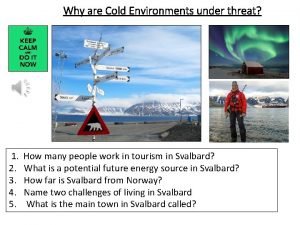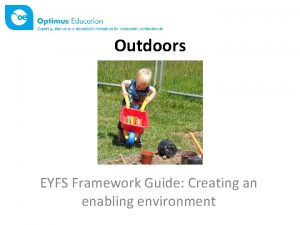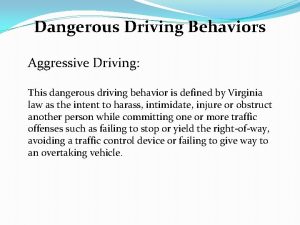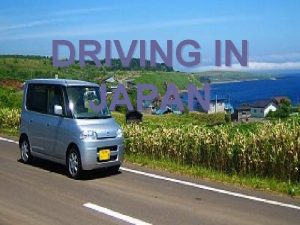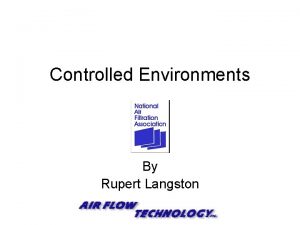lesson 15 5 SPECIAL DRIVING ENVIRONMENTS Driving through





























- Slides: 29

lesson 15. 5 SPECIAL DRIVING ENVIRONMENTS Driving through mountains and deserts can challenge your patience, energy, and skills. Be particularly aware of your vehicle’s gauges while driving.

OBJECTIVE Describe special safety precautions for mountain driving.

Mountain Driving Gravity will make your vehicle go faster when going downhill and slow your vehicle when going uphill.

Mountain roads often zigzag across a mountain with a series of sharp turns called switchbacks. A switchback bends sharply in the opposite direction.

What does the sign warn you about? What actions should you take?

Driving Up a Mountain You should accelerate steadily when driving uphill. On extremely steep hills, you may need to manually shift an automatic transmission vehicle into a lower gear. If you can’t see around a curve: • reduce your speed • move into lane position 1 • tap your horn Driving too fast is a leading cause of collisions in the mountains.

Loaded trucks, recreational vehicles (RVs), and vehicles pulling trailers move more slowly up mountain roads. Maintain at least a 4 -second following distance.

Some mountain roads have locations called pull-out areas where an additional right lane is provided for slower -moving vehicles. When slower-moving vehicles move into such lanes, fastermoving vehicles can safely pass and proceed. The copyright holder has not granted permission to display this photograph in a downloadable format. You may view the photograph in the Drive Right Presentation for this lesson on your Keys to Teaching Success disc.

Driving Down a Mountain When driving down a mountain road, downshift before you start traveling downhill. • Never coast downhill. • Adjust your speed with an occasional use of the brakes. • If you are braking often, shift to a lower gear. • Keep your speed low enough to maintain control and stay in your lane.

Some mountain roadways have runaway vehicle ramps, which are a place for vehicles, especially large trucks, to safely get out of traffic and stop when their brakes are no longer effective.

What are two safety components of this runaway vehicle ramp? The copyright holder has not granted permission to display this photograph in a downloadable format. You may view the photograph in the Drive Right Presentation for this lesson on your Keys to Teaching Success disc.

Weather in the Mountains Fog, snow, and ice can make mountain driving even more difficult. Before driving, check sources that update travelers on weather and road conditions. These frequencies are often identified on blue driver-service signs along the side of the road. To drive in some mountain areas in winter, vehicles should be equipped with snow tires and/or tire chains.

Effects of Altitude on Drivers High altitudes cause shortness of breath, faster heartbeat, and headache. Lower amounts of oxygen at higher altitudes can reduce concentration and cause drowsiness. Do not drive if you feel these effects or are tired.

Effects of Altitude on Vehicles • The climbing power of your car is reduced. • Acceleration can become sluggish. • The temperature of the water in your radiator may increase and cause overheating.

Check your gauges and warning lights often. Pull over and stop to let the engine cool if an engine light comes on. Turning on your heater may help remove some of the heat built up in the engine.

When you shut off your engine in the mountains, vapor lock occurs. The engine will not start because the fuel cannot be pumped in a gaseous state. Allow the engine to cool. Then try restarting it.

If you do a lot of mountain driving, have your vehicle serviced regularly for maximum performance.

safe driving tip Rockslides Mountains often have falling rock zones. Be especially alert for falling rock or boulders in the road in these zones. Be prepared to stop suddenly or swerve.

OBJECTIVE Describe special safety precautions for desert driving.

Desert Driving Desert driving is hard on the driver, the car, and the roadway. Always prepare yourself and your vehicle for driving in desert climates.

Effects of Heat on Drivers Intense daytime heat can cause great stress. The sameness of the scenery can lull you into a false sense of security. Intense glare from the sun can reduce your vision. To help reduce the effects of driving in a hot desert: • wear sunglasses • make frequent stops • change drivers often • carry plenty of water

Effects of Heat on Vehicles Battery fluids should be checked daily if the battery is not self-contained. Radiator fluids should be checked at every fuel stop. CAUTION: Never remove a radiator cap from a hot radiator. The steam and hot fluid could burn you. If you must check the level in the radiator, wait until your engine cools.

Check tire pressure regularly. It will increase as you drive. A tire with low air pressure will run hotter, which could result in tire failure.

The Desert Roadway Some desert roadways have speed limits of 75 or 80 mph. Be careful of sandy roadside shoulders. If you need to pull over, make sure the location you select is firm and out of traffic.

Sandstorms and Dust Storms If you get caught in a sand or dust storm: • slow immediately and pull over to a safe place • turn off your headlights and turn on your hazard flashers • wait in your vehicle until the storm passes

If you must drive, go slowly. Visibility can be limited in a sandstorm. Why should you use low beams when driving in a sandstorm? The copyright holder has not granted permission to display this photograph in a downloadable format. You may view the photograph in the Drive Right Presentation for this lesson on your Keys to Teaching Success disc.

As soon as possible after the storm, have your oil, oil filter, and air filter changed. Dirt particles from the storm that remain in your fuel injection system and engine oil can cause excessive engine wear and damage.

Flash Floods A flash flood is a sudden, unexpected rush of water from heavy rain. A flash flood is dangerous in the desert because there is no soil to absorb runoff, so the ground washes away easily. If you encounter a flash flood: • seek higher ground immediately and wait for the water to recede • stay away from creeks or natural drainage areas

lesson 15. 5 review 1. What safety precautions should you take when driving in mountains? 2. What safety precautions should you take when driving in deserts?
 Special driving conditions
Special driving conditions International business environments and operations
International business environments and operations Disadvantages of virtualization
Disadvantages of virtualization Components of business environment
Components of business environment Chapter 13 natural environments of europe
Chapter 13 natural environments of europe Stable prediction across unknown environments
Stable prediction across unknown environments Psychologically informed environments
Psychologically informed environments Psychologically informed environments
Psychologically informed environments Creating supportive environments smoking
Creating supportive environments smoking High quality supportive environments
High quality supportive environments Example of external environment in school
Example of external environment in school Example of model based reflex agent
Example of model based reflex agent Chapter 13 natural environments of europe
Chapter 13 natural environments of europe Jonassen constructivist learning environment
Jonassen constructivist learning environment Chapter 7 natural environments of north america
Chapter 7 natural environments of north america Economic activity
Economic activity Relationship between micro macro and market environment
Relationship between micro macro and market environment Ibm spectrum protect
Ibm spectrum protect What are the forces in the marketing environment
What are the forces in the marketing environment Information-intensive operating environments
Information-intensive operating environments Story openers
Story openers What is global marketing environment
What is global marketing environment International business chapter 5
International business chapter 5 Diverse learning environments survey
Diverse learning environments survey Enabling environments eyfs
Enabling environments eyfs International business environments and operations
International business environments and operations Exercise in hot and cold environments
Exercise in hot and cold environments International business environments and operations
International business environments and operations Diverse learning environments survey
Diverse learning environments survey Through one man sin entered the world, and through one man
Through one man sin entered the world, and through one man












